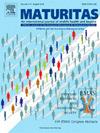Motoric cognitive risk syndrome and epigenetic aging in a cohort of the community-dwelling aging population
IF 3.6
2区 医学
Q2 GERIATRICS & GERONTOLOGY
引用次数: 0
Abstract
Background
Preventing dementia is a global priority. Motoric cognitive risk (MCR) is a pre-dementia syndrome comprising age-related functional declines; however, there is little evidence of its association with accelerated aging.
Objective
To investigate the cross-sectional association between MCR and epigenetic aging using 13 DNA methylation (DNAm) clocks.
Methods
A total of 2949 participants from the Health and Retirement Study (HRS) cohort were included in this study. Of the 13 epigenetic clocks, nine were first-generation clocks and four were second-generation. The association between the prevalence of MCR and epigenetic aging clocks along with their accelerated aging (AccelAge) measures was calculated using logistic and linear regression models.
Results
The prevalence of MCR was 1.90 %; those with the syndrome had a mean age of 69.7 years. MCR was associated with Horvath 2, YANG, and GrimAge DNAm clocks in both logistic and linear regression models. Individuals with MCR had a higher rate of accelerated aging according to Horvath 2 AccelAge (OR = 1.37, 95 % CI = 1.02–1.85, P = 0.035), YANG AccelAge (OR = 1.29, 95 % CI = 1.03–1.62, P = 0.024) and GrimAge AccelAge (OR = 1.47, 95 % CI = 1.07–2.04, P = 0.019) in the logistic regression model, and Horvath 2 AccelAge (β = 0.34, 95 % CI = 0.04–0.64, P = 0.027), YANG AccelAge (β = 0.41, 95 % CI = 0.13–0.68, P = 0.003) and GrimAge AccelAge (β = 0.28, 95 % CI = 0.03–0.52, P = 0.025) in the linear regression model. A linear dose-response relationship with relative risk of MCR was observed in the multivariable-adjusted restricted cubic splines curves.
Conclusion
MCR was found to be a state of accelerated aging according to Horvath 2, YANG, and GrimAge DNAm clocks. Individuals with accelerated aging as measured by GrimAge had the highest odds of MCR. Epigenetic aging could serve as a marker for dementia risk in older individuals.
社区老年人群的运动认知风险综合征与表观遗传衰老
预防痴呆症是一项全球优先事项。运动认知风险(MCR)是一种痴呆症前期综合征,包括与年龄相关的功能下降;然而,几乎没有证据表明它与加速衰老有关。目的利用13种DNA甲基化(DNAm)时钟研究MCR与表观遗传衰老的横断面关联。方法从健康与退休研究(HRS)队列中选取2949名参与者。在13个表观遗传时钟中,9个是第一代时钟,4个是第二代时钟。使用逻辑和线性回归模型计算MCR患病率与表观遗传衰老时钟及其加速衰老(AccelAge)措施之间的关系。结果MCR患病率为1.90%;这些患者的平均年龄为69.7岁。在逻辑和线性回归模型中,MCR与Horvath 2、YANG和GrimAge DNAm时钟相关。MCR的人有更高的加速老化霍瓦特根据2 AccelAge (OR = 1.37, 95% CI -1.85 = 1.02, P = 0.035),杨AccelAge (OR = 1.29, 95% CI -1.62 = 1.03, P = 0.024)和GrimAge AccelAge (OR = 1.47, 95% CI -2.04 = 1.07, P = 0.019)在逻辑回归模型中,霍瓦特和2 AccelAge(β= 0.34,95% CI -0.64 = 0.04, P = 0.027),杨AccelAge(β= 0.41,95% CI -0.68 = 0.13, P = 0.003)和GrimAge AccelAge(β= 0.28,95% CI -0.52 = 0.03,P = 0.025)。在多变量调整的限制性三次样条曲线上观察到MCR相对危险度与剂量-反应呈线性关系。结论根据Horvath 2、YANG和GrimAge DNAm时钟,mcr为加速衰老状态。根据GrimAge的测量,加速衰老的个体患MCR的几率最高。表观遗传衰老可以作为老年人患痴呆症风险的标志。
本文章由计算机程序翻译,如有差异,请以英文原文为准。
求助全文
约1分钟内获得全文
求助全文
来源期刊

Maturitas
医学-妇产科学
CiteScore
9.10
自引率
2.00%
发文量
142
审稿时长
40 days
期刊介绍:
Maturitas is an international multidisciplinary peer reviewed scientific journal of midlife health and beyond publishing original research, reviews, consensus statements and guidelines, and mini-reviews. The journal provides a forum for all aspects of postreproductive health in both genders ranging from basic science to health and social care.
Topic areas include:• Aging• Alternative and Complementary medicines• Arthritis and Bone Health• Cancer• Cardiovascular Health• Cognitive and Physical Functioning• Epidemiology, health and social care• Gynecology/ Reproductive Endocrinology• Nutrition/ Obesity Diabetes/ Metabolic Syndrome• Menopause, Ovarian Aging• Mental Health• Pharmacology• Sexuality• Quality of Life
 求助内容:
求助内容: 应助结果提醒方式:
应助结果提醒方式:


